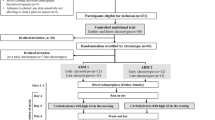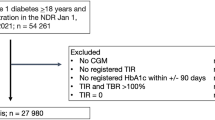Abstract
In current clinical and research practice, the determination of diabetic status depends largely on plasma glucose levels 2 h after the ingestion of a standard 75-g glucose load, the oral glucose tolerance test (OGTT). The OGTT, however, remains inconvenient, not highly reproducible, and costly, especially for large-scale studies and population screening tests. Fasting plasma glucose (FPG) determinations are convenient, reliable, and valid measures of glucose intolerance, but the currently prescribed cut-off point of 140 mg/dl (7.8 mM) lacks sensitivity. We evaluated the reliability and validity of fasting plasma glucose (FPG) values compared with other measures of hyperglycemia for a diagnosis of diabetes in a populationbased study of carbohydrate metabolism in Wadena, Minnesota, a community of predominantly northern European ancestry. As a part of this effort, a random sample of Wadena adults, stratified by age and gender, plus all known, previously diagnosed diabetics participated in 2 days of baseline testing and were followed prospectively and retested 5 years later. Cross-sectional analyses of baseline data are presented in this article. Diabetic status was ascertained by administering a standard OGTT according to National Diabetes Data Group (NDDG) specifications. Sensitivity and specificity levels obtained when using a FPG cut-off point of 6.4 mM were 95.2% and 97.4%, respectively. In study subjects with no known diagnosis of diabetes, the FPG cut-off point of 6.4 mM performed reasonably well with a sensitivity and specificity of 67.7% and 97.4%, respectively. A receiver operating characteristic (ROC) curve analysis showed that FPG consistently performed better than glycosylated hemoglobin in distinguishing diabetic from non-diabetic subjects. FPG concentrations accurately and reliably discriminate diabetic from non-diabetic individuals in a population-based study of Caucasians of northern European ancestry.
Similar content being viewed by others
References
American Diabetes Association. Office guide to diagnosis and classification of diabetes mellitus and other categories of glucose intolerance. Diabetes Care 16 [Suppl 2]:4, 1993
American Diabetes Association. Screening for diabetes. Diabetes Care 16 [Suppl 2]:7–9, 1993
WHO Expert Committee on Diabetes Mellitus. Technical Report 646. WHO, Geneva, 1980
Harris M. Classification and diagnostic criteria for diabetes and other categories of glucose intolerance. In: Harris M, Hamman R (eds) Diabetes in America. (DHHS publ. no. 85-1468, chapter II) US Govt. Printing Office, Washington, DC, pp 1–10, 1985
National Diabetes Data Group. Classification and diagnosis of diabetes mellitus and other categories of glucose intolerance. Diabetes 28:1039–1057, 1979
Ganda O, Day J, Soeldner J, Connon J, Gleason R. Reproducibility and comparative analysis of repeated intravenous and oral glucose tolerance tests. Diabetes 27:715–725, 1978
LeFloch J-P, Baudin E, Escuyer P, Wirquin E, Yomtov B, Perlemuter L. Short reports: reproducibility of glucose and insulin responses to mixed meal in type II diabetic patients. Diabetes Care 14:138–140, 1991
Cockram C, Lau J, Chan A, Woo J, Swaminathan R. Assessment of glucose tolerance test criteria for diagnosis of diabetes in Chinese subjects. Diabetes Care 15:988–990, 1992
Flock E, Bennett P, Savage P, Webner C, Howard B, Rushforth N, Miller M. Bimodality of glycosylated hemoglobin distribution in Pima Indians. Diabetes 28:984–989, 1979
Finch C, Zimmet P, Alberti K. Determining diabetes prevalence: a rational basis for the use of fasting plasma glucose concentrations? Diabetic Med 7:603–610, 1990
Little R, England J, Wiedmeyer H, McKenzie E, Pettitt D, Knowler W, Goldstein D. Relationship of glycosylated hemoglobin to oral glucose tolerance. Implications for diabetes screening. Diabetes 37:60–64, 1988
Modan M, Karasik A, Lusky A. Effectiveness of glycosylated hemoglobin, fasting plasma glucose, and a single post load plasma glucose level in population screening for glucose intolerance. Am J Epidemiol 119:431–444, 1984
Orchard T, Daneman D, Becker D, Kuller L, LaPorte R, Drash A, Wagener D. Glycosylated hemoglobin: a screening test for diabetes mellitus? Prev Med 11:595–601, 1982
Santiago J, Davis J, Fisher F. Hemoglobin Alc levels in a diabetes detection program. J Clin Endocrinol Metab 47:578–580, 1978
Simon DCM, Thibult N, Senan C, Eschwege E. Comparison of glycosylated hemoglobin and fasting plasma glucose with two-hour post-load plasma glucose in the detection of diabetes mellitus. Am J Epidemiol 122:589–593, 1985
Tsuji I, Nakamoto K, Hasegawa T, Hisashige A, Inawashiro H, Fukao A, Hisamichi S. Receiver operating characteristic analysis on fasting plasma glucose, HbA lc, and fructosamine on diabetes screening. Diabetes Care 14:1075–1077, 1991
Robertson D, Alberti K, Dowse G, Zimmet P, Tuomilehto J, Gareeboo H. Is serum anhydroglucitol an alternative to the oral glucose tolerance test for diabetes screening? Diabetic Med 10:56–60, 1993
US Department of Commerce, Economics and Statistics Administration, Census Bureau. 1990 Census of population and housing: summary of population and housing characteristics: Minnesota. US Government Printing Office, Washington DC, 1991
French L, Boen J, Martinez A, Bushhouse S, Sprafka J, Goetz F. Population-based study of impaired glucose tolerance and type II diabetes in Wadena, Minnesota. Diabetes 39:1131–1137, 1990
Klenk D, Hermanson G, Krohn R, Fujimoto E, Mallia A, Smith P, England J, Wiedmeyer H, Little R, Goldstein D. Determination of glycosylated hemoglobin by affinity chromatography: comparison with colorimetric and ion-exchange methods, and effects of common interferences. Clin Chem 28:2088–2094, 1982
Metz C. Basic principles of ROC analysis. Semin Nucl Med VIII:283–298, 1978
Hanley J, McNeil B. The meaning and use of the area under a receiver operating characteristic (ROC) curve. Radiology 143:29–36, 1982
SPSS Reference Guide. SPSS, Chicago, 1990
Metz C. CLABROC. (Apple Macintosh version) Department of Radiology, University of Chicago, 1991
Bender AP, Sprafka JM, Jagger H, Wannamaker J, Muckala KH. Incidence, prevalence, mortality and population-based profile of diabetes mellitus in Wadena, Minnesota, 1981. Minn Med 66:251–256, 1983
Bender AP, Sprafka JM, Jagger H, Wannamaker J, Muckala KH. Evaluation of the effect of record source on the profiles of patients with diabetes mellitus in Wadena, Minnesota. Minn Med 66:383–387, 1983
Bender A, Sprafka J, Muckala HK, Martin C, Edwards T. Incidence, prevalence, and mortality of diabetes mellitus in Wadena, Minnesota: The Three-City Study. Diabetes Care 9:343–350, 1986
Barrett-Connor E. The prevalence of diabetes mellitus in an adult community as determined by history or fasting hyperglycemia. Am J Epidemiol 111:705–712, 1980
Butler WJ, Ostrander J, Carman WJ, Lamphiear DE. Diabetes mellitus in Tecumseh, Michigan: prevalence, incidence, and associated conditions. Am J Epidemiol 116:971–980, 1982
Gardner LI Jr, Stern M, Haffner S, Gaskill S, Relethford J, Eifler C. Prevalence of diabetes in Mexican Americans: relationship to percent of gene pool derived from Native American sources. Diabetes 33:86–92, 1984
Hamman R, Marshall J, Baxter J, Kahn L, Mayer E, Orleans M, Murphy J, Lezotte D. Methods and prevalence of non-insulin dependent diabetes mellitus in a biethnic Colorado population: the San Luis Valley Diabetes Study. Am J Epidemiol 129:295–311, 1989
Hanis CL, Ferrell RE, Barton SA et al. Diabetes among Mexican Americans in Starr County, Texas. Am J Epidemiol 118:659–672, 1983
Harris M, Hadden W, Knowler W, Bennett P. Prevalence of diabetes and impaired glucose tolerance in the US population aged 20–74 yr. Diabetes 36:523–534, 1987
Harris M. Prevalence of noninsulin-dependent diabetes and impaired glucose tolerance. In: Harris M, Hamman R (eds) Diabetes in America. (DHHS publ. no. 85-1468, chapter VI) US Govt. Printing Office, Washington, DC, pp 1–31, 1985
Klein R, Klein BE, Moss SE, DeMets DL, Kaufman I, Voss PS. Prevalence of diabetes mellitus in southern Wisconsin. Am J Epidemiol 119:54–61, 1984
Palumbo PJ, Elveback LR, Chu C-P, Connolly DC, Kurland LT. Diabetes mellitus: incidence, prevalence, survivorship, and causes of death in Rochester, Minnesota, 1945–1970. Diabetes 25:566–573, 1976
Author information
Authors and Affiliations
Rights and permissions
About this article
Cite this article
Clements, J.P., French, L.R., Boen, J.R. et al. A reassessment of fasting plasma glucose concentrations in population screening for diabetes mellitus in a community of northern European ancestry: the Wadena City Health Study. Acta Diabetol 31, 187–192 (1994). https://doi.org/10.1007/BF00571949
Received:
Accepted:
Issue Date:
DOI: https://doi.org/10.1007/BF00571949




